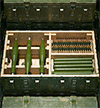AD: Companies, which are challenged by workforce shortages, are increasingly automating their operations, allowing them to boost productivity and profits. What has this done to their power requirements?
Dunbar: The challenge of workforce shortages has led many companies to adopt automation to improve their productivity and increase profits. In response to this shift, their power requirements have seen a noticeable uptick, and this trend is expected to persist. While this doesn't necessarily require an immediate transition from a lower power capacity demand to a higher one, it does suggest a significant rise in power demand when manual labor is replaced by automated processes. This is a critical consideration when assessing a client's inclination toward automation. As companies continue to automate their operations, they must be prepared for a continued and, in some cases, accelerated surge in their power requirements.
AD: Increased power demand is coming at a time when utilities are also trying to meet sustainability goals through the use of renewables. How are they handling these seemingly conflicting demands?
Dunbar: Companies face a complex challenge as they strive to align with sustainability and decarbonization objectives, which involve reducing their carbon footprint while concurrently increasing their electricity demands. These goals are driving companies to develop multifaceted decarbonization strategies. They are investing more in enhancing overall system efficiency, easing or eliminating the previously mandated return on investment (ROI) thresholds for efficiency projects. This strategic shift enables the integration of innovative technologies like heat pumps, optimizing energy utilization.

Beyond decarbonization, another pivotal aspect of sustainability is resiliency. The rising electrical demand places added stress on a company's electrical infrastructure and the local grid. In many cases, upgrading the electrical service becomes a necessity to accommodate heightened demands, provided the local grid can accommodate such expansion. However, site electrical upgrades can be resource-intensive and time-consuming. Companies must also factor in the quality of their existing electrical service and consider supply resiliency, which may include redundant feeds in specific instances.
AD: In brief, how are increased power demand and the need to fulfill sustainability goals affecting companies’ location plans?
Dunbar: The confluence of increased power demand and sustainability objectives has compelled companies to make thoughtful location plans that strike a balance between speed to market, proximity to power sources, scalable infrastructure, incremental growth, and strategic power management over time. These considerations are essential for companies looking to navigate the evolving landscape of power requirements and sustainability goals while remaining competitive and adaptable in their respective industries.
AD: Did the research for the White Paper that follows reveal any surprises?
Dunbar: The research for the White Paper has provided valuable insights into the reliability of renewable energy sources, the significance of cost considerations, and the practicality and speed of implementing sustainability goals. These findings suggest that a multifaceted approach is needed to bridge the gap between the aspiration for sustainable energy solutions and the present reality.



